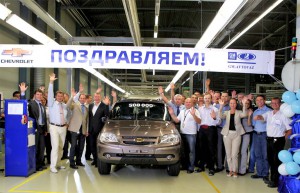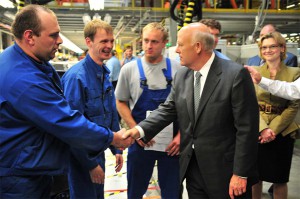
Hello, we must be going. A GM Niva rolls down the Avtovaz assembly line. Plans for an updated car have been scrubbed.
General Motors plans to largely abandon the Russian market, a move that goes well beyond the short-term production cuts announced by key rivals like Ford Motor Co. in response to the economic crisis crippling the heart of the former Soviet Union.
GM’s German-based Opel brand will pull out of Russia entirely by the end of this year, while Chevrolet will scale back to focus on a handful of products such as the Corvette and Camaro. The maker will continue to market Cadillac products to Russia’s luxury buyers, but production will shift back to the U.S.
“This change in our business model in Russia is part of our global strategy to ensure long-term sustainability in markets where we operate,” said GM President Dan Ammann. “This decision avoids significant investment into a market that has very challenging long-term prospects.”
(Europe back in gear. Sales grow for the 18th consecutive month. Click Here for more.)
Russia’s car market has been in freefall in recent months, largely the result of hefty economic sanctions levied over the country’s involvement in the Ukranian crisis. The recent collapse of the Russian ruble has only worsened the situation. Manufacturers have had to sharply raise prices in response, most also trimming back production in recent months.
Sales of new cars and light commercial vehicles tumbled to 2.49 million last year, down from 2.78 million in 2013. And the Association of European Businesses is forecasting sales will drop another 24% this year, to a mere 1.89 million vehicles.
With no clear turnaround in sight, GM had to weigh the cost of maintaining a competitive presence in Russia. That would have included not only the expansion of its assembly plant in St. Petersburg, but also the steps necessary to update vehicles produced under contract by local Russian producer GAZ.
Instead, GM will shutter the St. Petersburg plant by the middle of this year. Contract assembly by GAZ will be discontinued sometime in 2015, as well.
Opel will pull out of the market entirely by the end of December. And Chevrolet will focus on three primary models, the Corvette, Camaro and Tahoe while winding down sales of the Russian-made Niva. Development of a next-generation Niva has been “halted,” according to GM spokesman Dave Roman.
Cadillac, meanwhile, will remain in the market, appealing to the upscale buyers who have been less impacted by Russia’s economic problems than maintain motorists.
(Nissan stays bullish on Russia long-term, says CEO Ghosn. Click Here for the story.)
Though GM might eventually seek to rebuild a presence, company officials stressed that the changes are not just a temporary step to deal with Russia’s current economic crisis.
“We do not have the appropriate localization level for important vehicles built in Russia and the market environment does not justify a major investment to further localize,” said Opel Group CEO Karl-Thomas Neumann.
The move comes as a sharp retreat from the optimistic approach to Russia GM had announced only a few years ago.
In June 2012 GM broke ground on an expansion project aimed at boosting the capacity of the St. Petersburg plant from 98,000 to 230,000 annually. With its contract partner, meanwhile, the maker was aiming to build as many as 350,000 vehicles a year in Russia.
“Our growing investment is the strongest possible endorsement by General Motors of our intent to make Russia a significant part of our international operations,” former GM CEO Dan Akerson said at the time.
But even before Russia’s economic problems worsened last year, GM was already facing trouble. The maker hit its peak there in 2008, moving 337,810 vehicles. Sales in the country dipped to 288,000 in 2012, and to 258,000 a year later. And they plunged to just 189,000 in 2014. GM hasn’t released a target for this year.
Despite the Russian pull-out, GM says it still aims to put its European operations back in the black by 2016 after more than 15 years of red ink. It also is holding to a target of an 8% share of the European market , with 5% profit margins, by 2022. But the Russian move will result in a $600 million write-off this year.
(Ford facing “the squeeze” in Europe. Click Here for more.)

